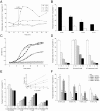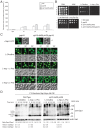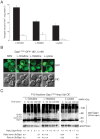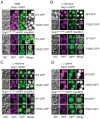Specific analogues uncouple transport, signalling, oligo-ubiquitination and endocytosis in the yeast Gap1 amino acid transceptor
- PMID: 24852066
- PMCID: PMC4285233
- DOI: 10.1111/mmi.12654
Specific analogues uncouple transport, signalling, oligo-ubiquitination and endocytosis in the yeast Gap1 amino acid transceptor
Abstract
The Saccharomyces cerevisiae amino acid transceptor Gap1 functions as receptor for signalling to the PKA pathway and concomitantly undergoes substrate-induced oligo-ubiquitination and endocytosis. We have identified specific amino acids and analogues that uncouple to certain extent signalling, transport, oligo-ubiquitination and endocytosis. L-lysine, L-histidine and L-tryptophan are transported by Gap1 but do not trigger signalling. Unlike L-histidine, L-lysine triggers Gap1 oligo-ubiquitination without substantial induction of endocytosis. Two transported, non-metabolizable signalling agonists, β-alanine and D-histidine, are strong and weak inducers of Gap1 endocytosis, respectively, but both causing Gap1 oligo-ubiquitination. The non-signalling agonist, non-transported competitive inhibitor of Gap1 transport, L-Asp-γ-L-Phe, induces oligo-ubiquitination but no discernible endocytosis. The Km of L-citrulline transport is much lower than the threshold concentration for signalling and endocytosis. These results show that molecules can be transported without triggering signalling or substantial endocytosis, and that oligo-ubiquitination and endocytosis do not require signalling nor metabolism. Oligo-ubiquitination is required, but apparently not sufficient to trigger endocytosis. In addition, we demonstrate intracellular cross-induction of endocytosis of transport-defective Gap1(Y395C) by ubiquitination- and endocytosis-deficient Gap1(K9R,K16R). Our results support the concept that different substrates bind to partially overlapping binding sites in the same general substrate-binding pocket of Gap1, triggering divergent conformations, resulting in different conformation-induced downstream processes.
© 2014 The Authors. Molecular Microbiology published by John Wiley & Sons Ltd.
Figures







Similar articles
-
The Gap1 general amino acid permease acts as an amino acid sensor for activation of protein kinase A targets in the yeast Saccharomyces cerevisiae.Mol Microbiol. 2003 Nov;50(3):911-29. doi: 10.1046/j.1365-2958.2003.03732.x. Mol Microbiol. 2003. PMID: 14617151
-
Stress conditions promote yeast Gap1 permease ubiquitylation and down-regulation via the arrestin-like Bul and Aly proteins.J Biol Chem. 2014 Aug 8;289(32):22103-16. doi: 10.1074/jbc.M114.582320. Epub 2014 Jun 18. J Biol Chem. 2014. PMID: 24942738 Free PMC article.
-
Substrate-induced ubiquitylation and endocytosis of yeast amino acid permeases.Mol Cell Biol. 2014 Dec;34(24):4447-63. doi: 10.1128/MCB.00699-14. Epub 2014 Sep 29. Mol Cell Biol. 2014. PMID: 25266656 Free PMC article.
-
Function and Regulation of Fungal Amino Acid Transporters: Insights from Predicted Structure.Adv Exp Med Biol. 2016;892:69-106. doi: 10.1007/978-3-319-25304-6_4. Adv Exp Med Biol. 2016. PMID: 26721271 Review.
-
Regulation of Sensing, Transportation, and Catabolism of Nitrogen Sources in Saccharomyces cerevisiae.Microbiol Mol Biol Rev. 2018 Feb 7;82(1):e00040-17. doi: 10.1128/MMBR.00040-17. Print 2018 Jun. Microbiol Mol Biol Rev. 2018. PMID: 29436478 Free PMC article. Review.
Cited by
-
Multiple Transceptors for Macro- and Micro-Nutrients Control Diverse Cellular Properties Through the PKA Pathway in Yeast: A Paradigm for the Rapidly Expanding World of Eukaryotic Nutrient Transceptors Up to Those in Human Cells.Front Pharmacol. 2018 Mar 13;9:191. doi: 10.3389/fphar.2018.00191. eCollection 2018. Front Pharmacol. 2018. PMID: 29662449 Free PMC article. Review.
-
Study of the Plasma Membrane Proteome Dynamics Reveals Novel Targets of the Nitrogen Regulation in Yeast.Mol Cell Proteomics. 2017 Sep;16(9):1652-1668. doi: 10.1074/mcp.M116.064923. Epub 2017 Jul 5. Mol Cell Proteomics. 2017. PMID: 28679684 Free PMC article.
-
Regulation of Amino Acid Transport in Saccharomyces cerevisiae.Microbiol Mol Biol Rev. 2019 Oct 16;83(4):e00024-19. doi: 10.1128/MMBR.00024-19. Print 2019 Nov 20. Microbiol Mol Biol Rev. 2019. PMID: 31619504 Free PMC article. Review.
-
Identification of Ftr1 and Zrt1 as iron and zinc micronutrient transceptors for activation of the PKA pathway in Saccharomyces cerevisiae.Microb Cell. 2017 Mar 2;4(3):74-89. doi: 10.15698/mic2017.03.561. Microb Cell. 2017. PMID: 28357393 Free PMC article.
-
Sul1 and Sul2 sulfate transceptors signal to protein kinase A upon exit of sulfur starvation.J Biol Chem. 2015 Apr 17;290(16):10430-46. doi: 10.1074/jbc.M114.629022. Epub 2015 Feb 27. J Biol Chem. 2015. PMID: 25724649 Free PMC article.
References
-
- Andre B. Haguenauer-Tsapis R. Membrane trafficking of yeast transporters: mechanisms and physiological control of downregulation. Top Curr Genet. 2004;9:273–323.
-
- Apostolaki A, Erpapazoglou Z, Harispe L, Billini M, Kafasla P, Kizis D, et al. AgtA, the dicarboxylic amino acid transporter of Aspergillus nidulans, is concertedly down-regulated by exquisite sensitivity to nitrogen metabolite repression and ammonium-elicited endocytosis. Eukaryot Cell. 2009;8:339–352. - PMC - PubMed
Publication types
MeSH terms
Substances
LinkOut - more resources
Full Text Sources
Other Literature Sources
Molecular Biology Databases

